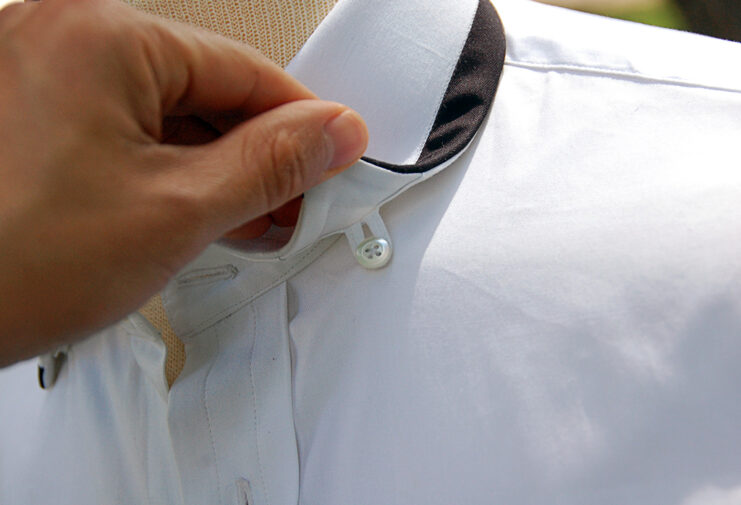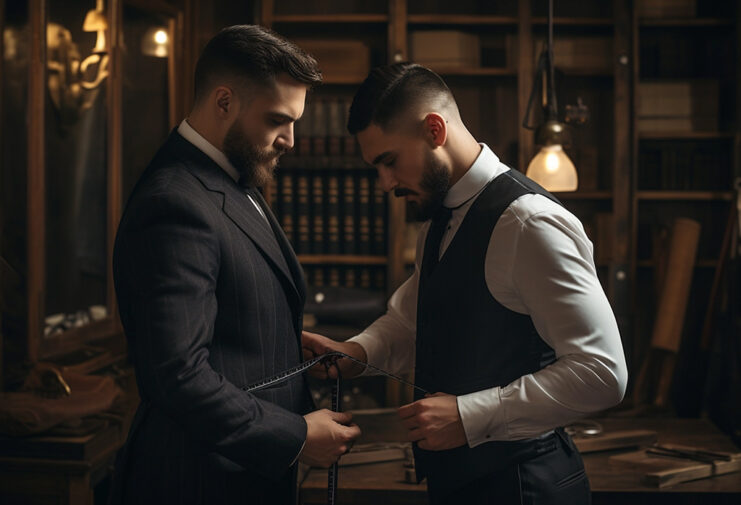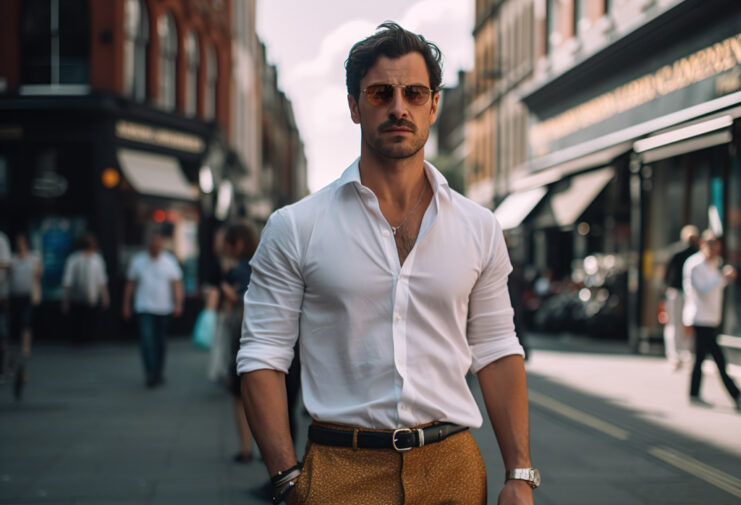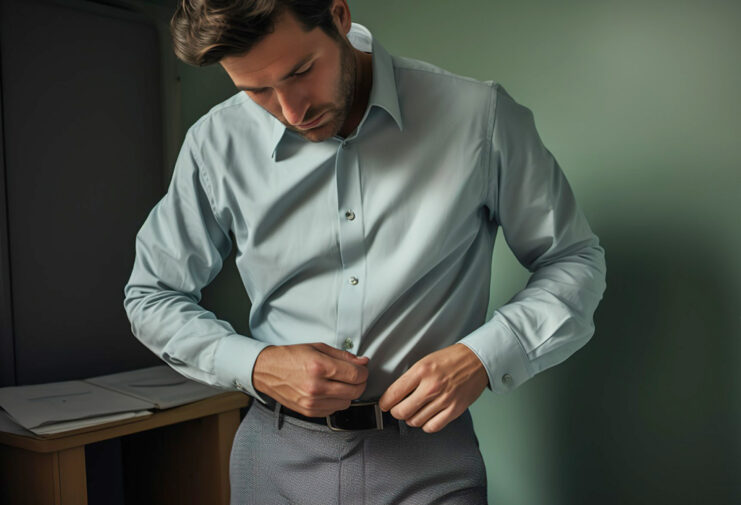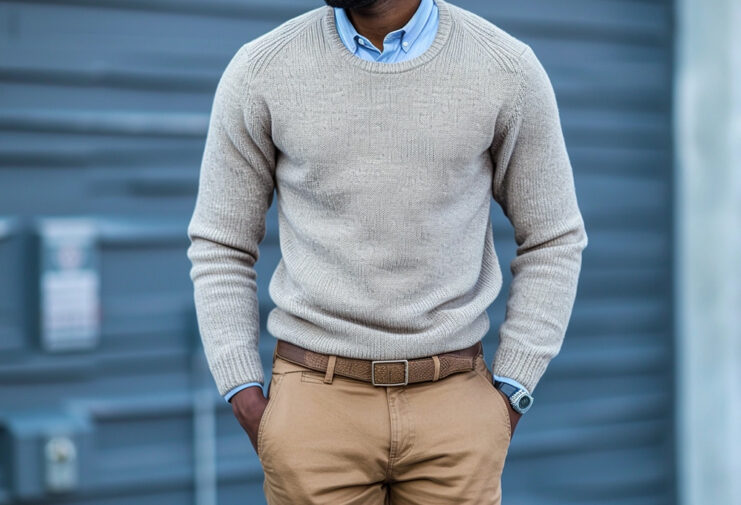Worth keeping in mind: each of these styles will look better when properly fitted!
The right kind of shirt in the wrong fit still looks bad. Make sure you've got the right fit in the right places:
- Collar is loose enough to slide a fingertip under and no more. It shouldn't stand off the body with air in between your neck and the shirt.
- Long sleeves should cover the large, protruding bone in the wrist when buttoned. The hole where the sleeve meets the shirt should be close in to the armpit, not sagging loose beneath it.
- Short sleeves should be tight enough to lie against the skin without digging in. If there's a sagging opening with empty air in it or cloth pinching the skin the fit needs adjusting.
- Shirt tails should never cover more than your belt, or a half-inch beyond it at the most. Most shirts meant to be worn untucked will be squared off at the same length all the way around, while shirts meant to be tucked in will have darts that give it a “duck tail” in the front and back.
- Waists can be brought in by a tailor, and should be if you need it. The shirt should taper with your body so that it's as close to the waist as it is to the ribs and chest. Looseness below the ribs will turn into a billowing distraction, or a “muffin top” puff around the trouser waist if you tuck it in.
In the case of long-sleeved shirts it's also worth making sure you can roll them up and keep them there comfortably in the changing room, before you buy the shirt.
You don't want a sleeve that slips back down and can't stay rolled during the hotter months.
Long-Sleeved Casual Shirts
The White Dress Shirt
For when “casual” needs to look a little sharper.
A good white dress shirt should have a point or spread collar (not button-down). If you can, get one with reasonably short tails so that you've got the option of wearing it untucked without long shirt tails hanging down in front.

These are most commonly worn as business wear, so it won't be a daily casual staple. But it's nice to have the option of dressing an outfit up by pairing very casual trousers or jackets with a sharp shirt.
The Blue Oxford
Every man should own at least one.
This is where “blue collar” came from (back in the days when collars were still detachable from shirts), and it's still a look that says “making the effort to look nice, but don't mistake me for a stuffed suit.”
You don't need a super-fine oxford for casual shirts. Something where the weave is visible dresses it down and adds some visual texture.
The Candy-Striped Button-Down
“Candystripe” is a common pattern of vertical lines alternating between a single solid color and white. Blue is the most common, but just about any color can be used. Its informality goes best with a button-down collar rather than the more dressy point or spread styles.
These are good shirts to wear with blazers and sports jackets, especially ones that don't have a pattern of their own. You get a little bit of a visual pop, and the jacket dresses the shirt up into something more lively than cubicle wear.
Be sure to keep this one in the “strictly casual” part of the closet, however. It's not something to wear with a business suit, even though it's a long-sleeved, collared dress shirt.
The Tattersall
Tattersall is a specific pattern of broad checks on a white background. You can actually get pretty nice ones that could be worn with suits in some situations, and these are the best ones to own; look for something in a fine cotton with a point or spread collar.
Worn untucked with the sleeves rolled these make a great casual shirt in the summer. Or throw them on under a navy blazer for something a little preppier.
It's not a common most men pick up automatically, but it's one of the most versatile in the casual wardrobe. A good long-sleeved shirt in tattersall is worth a bit of hunting.
The Plaid Workshirt
Not just for lumberjacks and hippies anymore. A restrained plaid on a light cotton work shirt looks great when paired with khakis or gray slacks. A relatively fine weave with a smooth surface can help set the shirt apart from the fuzzier flannels we associate with outdoorsmen.
Stick to two colors for best results, such as the classic red on black or a more urbane navy on white. Once you start getting into Scottish clan tartans it gets a little wild for anything outside of, yes, a lumberjack's flannel shirt.
The Rumpled Linen Shirt
Linen has a tendency to wrinkle easily. Lightweight summer shirts in a solid, light color showcase this as a feature rather than a bug, and it's worth owning one.
If you've seen magazine pictures of a good-looking guy on the beach, wearing a light-colored shirt with the sleeves rolled carelessly up, it was probably linen. Pair it with just about any color of cotton slacks, but never with linen pants of another color or a linen suit.
Short-Sleeved Casual Shirts
The Solid-Color Polo
Staple of the hotter months, this is another one every man should own. It can be worn as your only upper-body garment or slipped under a light jacket as needed.
The best (and coolest) polos should be made from a textured weave like poplin. The dimples help hold it off the skin, allowing air to flow through.
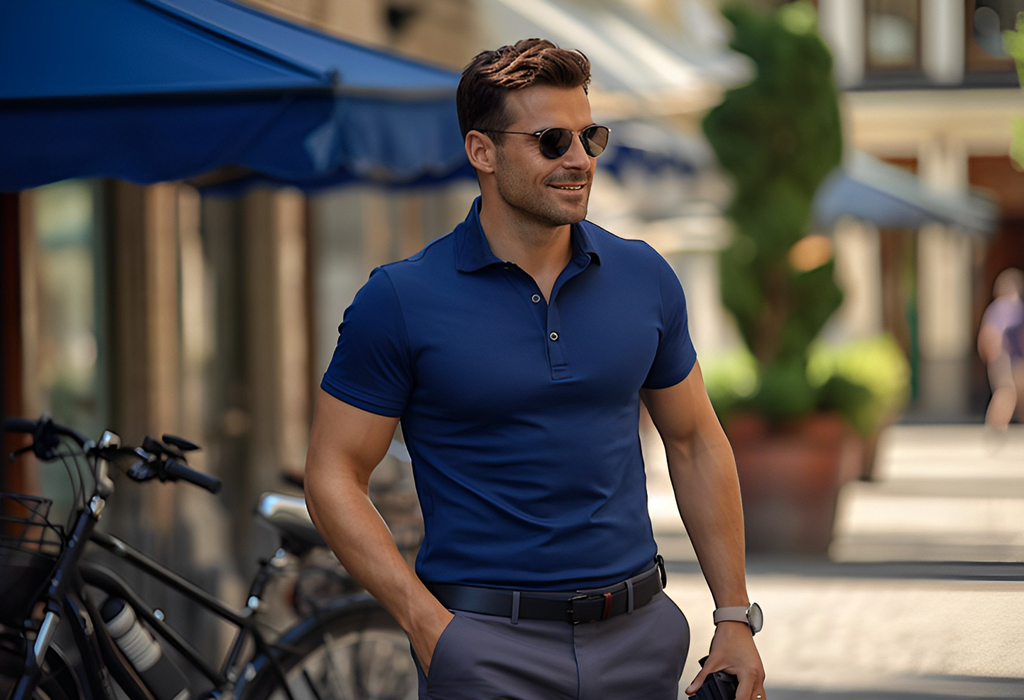
Avoid wearing polos with a company's logo on the left breast except when you are on the clock working for that company. Get blank ones for your casual wear.
The Short-Sleeved Work Shirt
This is often just a short-sleeved, square-bottomed version of a blue oxford or chambray work shirt. It has a buttoning front, a turndown collar, and one or two patch pockets on the breast.
These are best worn when you're actually going to be working. At social events they make you look a bit too much like a car mechanic. And speaking of car mechanics, don't wear work shirts with a sewn-on nametag except when you're working somewhere that requires it.
The Seersucker Button-Down
Short-sleeved seersucker shirts with a button front and button-down collar are a summer package of lightweight, breathable, and stylish. Blue-and-white candystripe is common, but a solid or a more variegated striping work just as well.
One thing to avoid, however, is wearing a seersucker shirt with a seersucker suit, jacket, or trousers. Pick whether you want to wear the shirt or the suit (or separates), but never both.
The Guayabera
Sometimes called a “Mexican Wedding Shirt,” the guayabera can be long- or short-sleeved, but the short-sleeved variant is much more common in the United States.
A guayabera is a light cotton collared shirt with four front pockets and at least two vertical columns of closely-spaced pleats, ruffles, or decorative stitching (or some combination of all of those). They usually come in a single light pastel.
A well-fitted guayabera gives you the same basic shape and style as a man in a short-sleeved dress shirt, but with a much more distinctive shirtfront. Its usefulness in summer casual should not be underestimated.
The Graphic T-Shirt
There's a time and a place for everything, even a T-shirt.
On it's own it's not a very flattering garment. But worn under a casual jacket, or paired with brightly-colored trousers, a T-shirt with an artistic design on it has become part of the young trendster's uniform.
A slightly less affected alternative is to wear a solid, dark T-shirt instead. This goes well beneath a blazer, or with accents like a scarf or broad, colored belt. Again, however, use it sparingly — a T-shirt should not be a daily staple.
